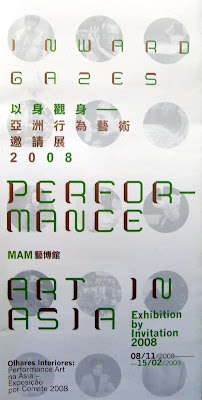

Inward Gazes: Performance Art in Asia – Exhibition by Invitation 2008
I like this exhibition very much. It is prepared and hosted by the Macao Museum of Art of the Civic and Municipal Affairs Bureau. There are totally 15 famous contemporary Asian artists’ works in this exhibition. These artists are from different regions in Asia such as Mainland China, Taiwan, Japan, South Korea, Singapore, Thailand, Vietnam, etc.
Artists from Asia presented their thoughts in different cultural contexts as they all have different nationalities, cities, regions and groups. In this exhibition, I am glad that I have the chance to uncover some of the Asia features in their art works.
Here are some of their works:
Phantom of History
Yao Jui-Chung (Taiwan)
Location: Taiwan
Video: Wu Dakun, Lin Fangyu, Chen Yi Zhang
Date: 2–5,11/2007
If art’s posture in history is indicative of art’s value, then does the degree of art’s clash with society determine its value? In Taiwan’s tangled historical and social setting, how one reflects on life by virtue of art’s relationship to life is what the exhibit Phantom of History addresses.
On the Table
Seiji Shimoda (Japan)
Location: Warsaw Contemporary Art Center, Poland
Date: 10/5/2008
Table is an artificial tool which no other animal will use. Table is useful too, at the time of eating, working and meeting friends etc. But those times, our human bodies are always separated by the upper half and the lower half of the table.
Through this performance, the artist tried to see what really happens if he put the whole body on the table.
Lunch
Mimi Fadmi (Indonesia)
Location: Rijksakademie van Beeldende Kunsten,Amsterdam, Netherland; Berlin, Germany; Venice Italy; Bangkok, Thailand; Bandung, Indonesia
Photograph: Daniel
Date: 9/9/2003
Sometimes life is harmful and irritable, feels like having lunch with plenty of red chilies.




Kiss
He Chengyao (Beijing, China)
Location: House of World Cultures, Berlin, German
Date: June, 2008
This performance requires free interaction between audience and artists. The audience can decide whether to act and how to act. Each member of the audience who participates in the performance can select an ice-lolly—the experience is full of unknowns, fortuities and uncertainties.
The performance appears to be an adventure. With an ice-lolly of unknown flavor in our mouths, we accept it as a bridge that attaches two separate worlds existing in a motley group of relationships, which makes us feel, discover, communicate, resist and compare. When we express our physical and psychological selves through actions, we see the dynamic relationship of phenomena influenced by the politics, economy, cultural environment and personal will behind our individual worlds. This demonstrates that we are products of the influence of society, culture, history, biological nature and individuality—and how such entities differ from each other in reacting to various relationships.
















